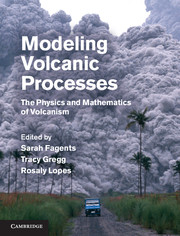Book contents
- Frontmatter
- Contents
- Contributors
- Chapter 1 Introduction
- Chapter 2 Magma chamber dynamics and thermodynamics
- Chapter 3 The dynamics of dike propagation
- Chapter 4 Dynamics of magma ascent in the volcanic conduit
- Chapter 5 Lava flows
- Chapter 6 Unsteady explosive activity
- Chapter 7 Unsteady explosive activity
- Chapter 8 Sustained explosive activity
- Chapter 9 Modeling tephra sedimentation from volcanic plumes
- Chapter 10 Pyroclastic density currents
- Chapter 11 Magma–water interactions
- Chapter 12 Deep-sea eruptions
- Chapter 13 Volcano–ice interactions
- Chapter 14 Modeling lahar behavior and hazards
- Chapter 15 Introduction to quantitative volcano seismology
- Chapter 16 Volcano acoustics
- Chapter 17 Planetary volcanism
- Index
- Plate section
- References
Chapter 9 - Modeling tephra sedimentation from volcanic plumes
Published online by Cambridge University Press: 05 March 2013
- Frontmatter
- Contents
- Contributors
- Chapter 1 Introduction
- Chapter 2 Magma chamber dynamics and thermodynamics
- Chapter 3 The dynamics of dike propagation
- Chapter 4 Dynamics of magma ascent in the volcanic conduit
- Chapter 5 Lava flows
- Chapter 6 Unsteady explosive activity
- Chapter 7 Unsteady explosive activity
- Chapter 8 Sustained explosive activity
- Chapter 9 Modeling tephra sedimentation from volcanic plumes
- Chapter 10 Pyroclastic density currents
- Chapter 11 Magma–water interactions
- Chapter 12 Deep-sea eruptions
- Chapter 13 Volcano–ice interactions
- Chapter 14 Modeling lahar behavior and hazards
- Chapter 15 Introduction to quantitative volcano seismology
- Chapter 16 Volcano acoustics
- Chapter 17 Planetary volcanism
- Index
- Plate section
- References
Summary
Overview
Tephra erupted in volcanic plumes can be transported over distances of thousands of kilometers, causing respiratory problems to humans and animals, serious damage to buildings and infrastructure, and affecting economic sectors such as aviation, agriculture, and tourism. Models with different degrees of complexity have been developed over the last few decades to describe tephra dispersal. Depending on the application, different simplifications and assumptions can be introduced to make the problem tractable. Highly sophisticated models are not suited for the computationally expensive probabilistic calculations required by long-term hazard assessments. In contrast, the simplified models typically used for probabilistic assessments have to compromise the sophistication of the physical formulation for computational speed. A comprehensive understanding of tephra deposits and hazards can only result from a critical and synergistic application of models with different levels of sophistication, ranging from purely empirical to fully numerical. A review of the main approaches to tephra dispersal modeling is presented in this chapter.
Introduction
Explosive volcanic eruptions have intrigued scientists because of their dramatic display of physical processes, their crucial role in the geological evolution of Earth, and their potentially catastrophic consequences for society. A key way of improving our understanding of explosive volcanism is to study the resulting pyroclastic deposits, which often represent the only direct evidence of explosive eruptions. Tephra deposits retain a considerable amount of information about the nature of the eruption, such as erupted mass, bulk grain-size distribution, and eruption intensity. However, tephra falls also represent significant hazards for people living close to active volcanoes. These hazards include collapse of buildings, disruption to water and electricity supplies, disruption to transportation networks, as well as health hazards from respirable ash, crop pollution, and lahar generation. Developing an understanding of tephra fall is crucial to public safety. In this chapter tephra is used in the original sense of Thorarinsson (1944) as a collective term for all particles ejected from volcanoes, irrespective of size, shape, and composition, whereas tephra fall indicates the process of particle fallout.
- Type
- Chapter
- Information
- Modeling Volcanic ProcessesThe Physics and Mathematics of Volcanism, pp. 173 - 202Publisher: Cambridge University PressPrint publication year: 2013
References
- 23
- Cited by



